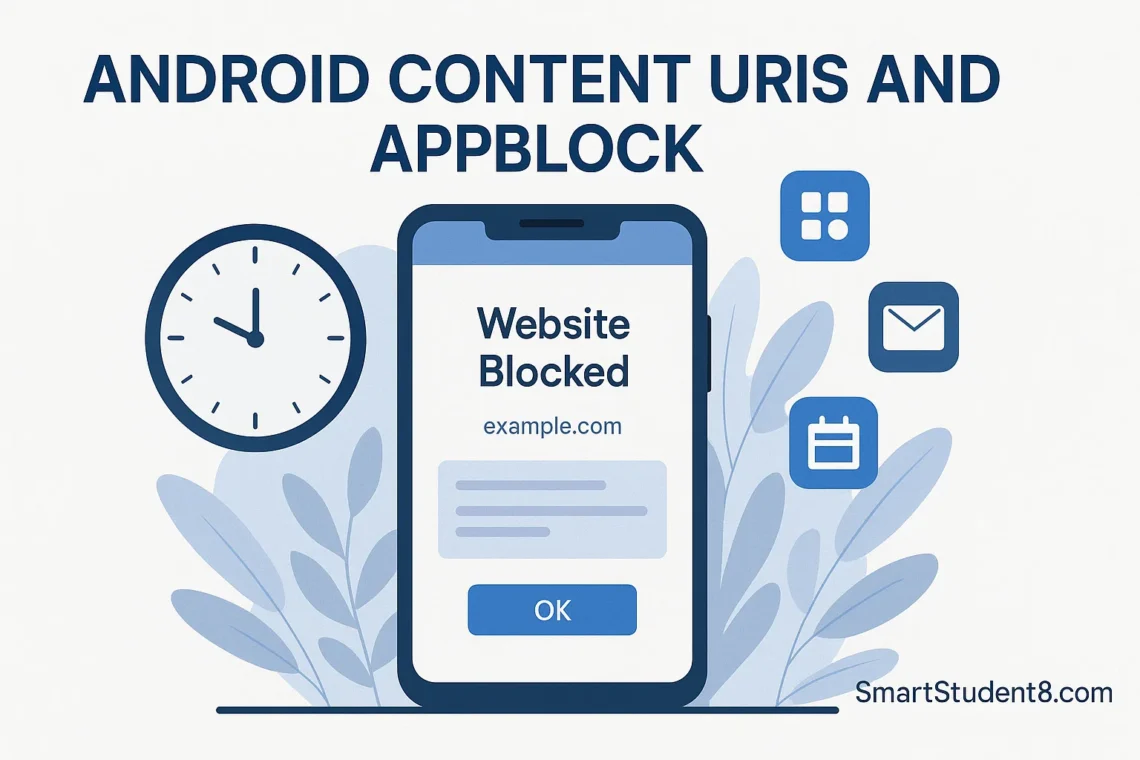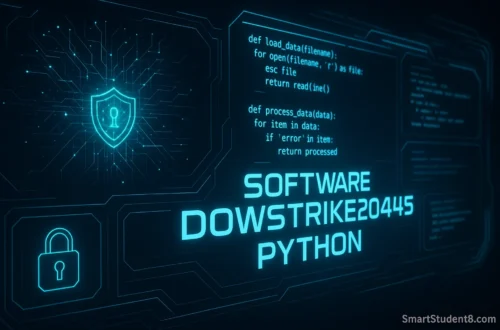If you’ve ever explored your Android phone’s logs, used a file cleaning app, or are just a curious tech enthusiast, you might have stumbled upon a cryptic-looking string: content://cz.mobilesoft.appblock.fileprovider/cache/blank.html. Being confronted with something this technical is unnerving. The URL doesn’t seem like the typical file or website path. This leads to the question: Is this a virus or not? My data is at risk. How can I find out what this odd entry is doing?
After years of playing with Android OS and building apps, I know that this path is often more fascinating than frightening. The path shows how the modern apps that focus on productivity and security work. The string in question is associated with a popular app for productivity called AppBlock. While its existence isn’t a bad thing, it is an excellent example of a secure and clever app design. The Uniform Resource Identifier or URI tells a narrative about how Android devices manage data. This mystery can be broken down into pieces to help you understand it.
What is the Android Content URI (Uniform Resource Identifier)?
To understand how to handle the entire string, it is important that we first grasp its essence: the prefix “content ://””. Android is a world where not all paths have the same meaning. Android has a much more advanced system called a content URI. You might know Windows’ file paths, which look something like CUsersDocuments. It’s a managed, secure address to a specific piece of information within an application. A secure temporary link can be created by an app to allow other apps to access its files without giving direct access. Here, Content URIs play a crucial role in the Android security system.
This system serves as a gateway. The raw file path is not passed to the app that wants to open a document from a different application (say, attaching an image from a gallery into an email). The Content URI is what it receives instead. It uses the URI as a way to get the permission of the “owner app” for accessing the data. The rogue app cannot access your files. We’re looking at one of the addresses on this list.
How to decode the URI step-by-step
Let’s dissect the string content://cz.mobilesoft.appblock.fileprovider/cache/blank.html to understand what each part signifies. Each segment is important, and it can be confusing to read everything at once. Like reading the address of an envelope where every line helps narrow down the exact location.
This is the breakdown of each component:
content://: Here is the scheme. The Android system is immediately informed that the Content URI has been used and that it’s controlled by a Content Provider. The first hint that the link is not an ordinary file or website.cz.mobilesoft.appblock.fileprovider: This is the authority. The identifier is unique and points at the particular Content Provider in charge of the data. In this case, it clearly namescz.mobilesoft.appblock, which is the package name for the AppBlock application developed by MobileSoft..fileprovideris a suffix that indicates a specific type of Content provider designed for sharing files securely./cache/: is the path segment. The path segment tells you that the file is in the cache directory of the application. It is used by apps to store data that they want access to immediately. It could be images, files that are temporary, or in this case, just a simple HTML web page.Blank.html: This file is being referenced. The HTML file is simple and likely empty.
When you combine all of this, the URI becomes a secure pointer for a file named Blank.html that is stored in the AppBlock temporary cache. This is a straightforward address.
The AppBlock File: What is it and why does the App need it?
AppBlock helps us understand the purpose of this file. AppBlock helps users to focus by blocking apps and sites. AppBlock allows you to set a time limit for which you won’t be able to access social media sites or news websites. AppBlock is an excellent tool for improving your focus and digital well-being. It has helped me to stay focused during work sprints when my mind is easily distracted by Twitter and Reddit.
When AppBlock stops a website from loading, what is the message it should display? It could make you think that the site is not working or your internet connection is down if AppBlock returns a browser-error page. The user would have a very poor experience. AppBlock must find a graceful way to show you the “blocked page”. Blank.html can help. Apps can direct your browser to a simple, locally stored HTML file. It could either be completely empty, or simply contain the message “This site has been blocked by AppBlock.” AppBlock ensures that blocking is immediate and does not require internet access by using the local cached files.
How to secure your app using a file-provider
fileprovider is one of the terms that are used in our URI. A File Provider subclass is designed specifically to allow files to be shared securely. In early Android versions, some apps exposed their files’ direct paths when sharing them. The security risks were huge. It is possible that sensitive data could be accessed if an app knows the structure of another’s file. Google’s security upgrades include FileProvider, which is designed to fix this problem.
A file provider generates a Content URI, which hides the real file path. This allows an app to temporarily grant another app read and write permissions on a specific URI. Permissions expire when the other app finishes with the files. File provider security is dependent on this. AppBlock may create a URL for Blank.html on your device, but it cannot be used by other applications to browse AppBlock’s internal directory. AppBlock needs to explicitly give permission. This usually happens when AppBlock deliberately displays the block page of its website in a browser.
Why Do You Use Cache? Cache File Management: Why is it Important?
Why is this blank.html stored in the /cache/ directories? The two primary types of app internal storage are permanent storage and the cache. It is used for temporary data that can be recreated by the app if it gets deleted. The cache is the best place to put a placeholder HTML document.
The cache can be the best choice.
- Performance: A file loaded from the cache on your computer is extremely fast. It’s much faster than downloading a page from the web. AppBlock will block a particular site and the replacement page is displayed instantly. This provides a seamless experience for users.
- Efficiency: Files in the cache don’t have to remain permanent. Android will automatically delete an app’s data cache when the storage is low.
Blank.htmlcan be easily recreated by the app, so it is the perfect file to cache. - Cleanliness: Cache file management is important to maintain the smooth operation of your device. AppBlock tells the system to remove temporary files if they’re not needed.
Over time, I have seen some apps store large non-essential data files permanently. This can cause a device to slow and bloat. AppBlock uses the cache to this end, which is good practice.
Content cz appblock fileprovider blank html – Is it a Risk?
After analyzing the URI, we are able to answer this most important question with certainty: Does it pose a security risk? It is an absolute no. The answer is a definitive no. AppBlock uses this feature to function normally. The presence of this icon indicates that an app uses modern and secure Android practices to manage and present content.
The Android system manages the cache automatically. Android automatically manages its cache. The blank.html would not be affected negatively, but it is also useless, because AppBlock could recreate the file the next instance it was needed. This URI would be like seeing a cable of a car spark plug under your hood. This part may seem complex but is actually a standard component of any machine.
Where and when you may encounter this URI
There are some scenarios in which this string might appear. This string may appear in your log file if you’re a programmer or advanced user. Apps like System Cleaner, which look for temp files and delete them, may list this path as well. If an application that has a WebView components crashes in some cases, the URI could appear as part of the crash reports, particularly if it was related to rendering the web content. You may see this URI in your browser’s history, if AppBlock blocked the website that you were trying to access. Every time, this is a normal operation.
Library Card System Analogy
For this analogy to be more relevant, we’ll use real life. Imagine the storage on your smartphone is a large library that has many sections. Every section belongs to someone (an application). If you’re a librarian, it isn’t possible to walk right into an area that has restricted access and pick up a few books. It is necessary to request the book at the library’s front desk.
Here’s an analogy to help you:
- The App (e.g., AppBlock) is the owner of a private, restricted section of the library.
- The
blank.htmlfile is a specific book in that restricted section. - The Content Provider is the librarian at the front desk.
- The Content URI is the library card or request slip you fill out. It doesn’t tell you the exact shelf and row where the book is located, but it gives the librarian all the information they need to retrieve it for you.
AppBlock doesn’t allow another app to use the blank.html “book” if it is needed by another application (like a browser). This “request” slip sends the Content URI to Android (the library manager), which asks AppBlock to get the book. It keeps all the sections of the library organized and secure.
AppBlock App Features in Relation to the Process
AppBlock offers a number of core features which make understanding the Blank.html even easier. This app offers more than a simple blocking tool; it also includes a set of tools that help manage your digital habits.
Features include:
- Scheduled blockage: Set specific time periods or days to restrict apps and sites. You can block social media, for example, during the workday (9AM to 5PM). If you attempt to access a site blocked at 9 AM, you will see the
empty.html. - Location-Based Blocking: AppBlock is able to activate profiles that are based on location. It’s possible to create a profile called “Work”, which blocks all games at your office. The method for displaying the blocked page will remain the same.
- The Strict mode: This prevents the user from disabling blocks prior to the expiration of the set time. This reinforces the purpose of the app, and the
empty.htmlweb page is key to that enforcement.
Every time one of these features kicks in to block a website, the content://.../blank.html URI is likely involved behind the scenes to serve the placeholder page. The code>content://…/blank.html/code> URI is likely involved behind the scenes to serve the placeholder page.
The Final Thoughts – A Feature and Not a Fault
Encountering a technical string like content://cz.mobilesoft.appblock.fileprovider/cache/blank.html can be confusing, but as we’ve seen, it’s a perfect illustration of the secure and efficient design principles of the Android operating system. AppBlock uses a Fileprovider and a Content URI to correctly manage its resources, without exposing the app’s internal structure. This file is just a placeholder and the location of it in cache shows smart resource management.
The next time you see a Content URI that looks similar to one from another application, you will be able decode it. In place of a mysterious error, the clever system will be at work securely linking the dots between the apps, creating the seamless experience that we demand from our mobile devices. The feature is working as expected and it’s neither a bug nor a security threat.





